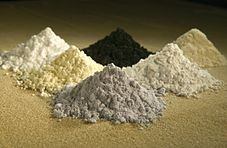Rare Earth Elements: Potential New Industry for WV & PA
By: David McCready, Ph.D., EnviroCalc
The rare earth elements (REE) are a series of 15 metals which are referred to as the lanthanides, lanthanum being the first element in the series. The REEs are important because they are necessary for use in many high tech electronic products for the military, industry, and consumers. The REEs have estimated values that range from $13/lb for lanthanum to $800/lb for lutetium; for comparison, the price for hard coking coal is about $0.10/lb.
Scandium and yttrium have similar chemical properties and occur with the lanthanides in natura so they may also be identified as REEs bring the total up to 17 REEs. REEs are relatively plentiful in earth despite their name “rare”. The metallic forms of REEs are not water soluble but they oxidize rapidly in moist air. The water soluble forms of REEs are the oxides, chlorides, nitrates, and sulfates. The human toxicity of REEs has not been well studied but the limited data indicate REEs are slightly to moderately toxic via inhalation and oral exposure. The REEs are typically found in a complex mixture with other compounds that are toxic, such as arsenic, or radioactive, such as uranium, or cause water quality issues (color, taste, and odor), such as iron.
The primary source of REEs is from mining in China. China limits their exports and this affects the worldwide supply and price for REEs. For strategic reasons, there is interest in re-developing the extraction and processing of REEs in the USA. Mining of REEs has been tried but the low concentrations in ore made it non-profitable in the USA. Mining also caused environmental issues, such as effluents that impacted downstream drinking water sources.
There is good news for WV and PA! High concentrations of REEs are associated with coal seams in  Appalachia, as well as with coal refuse from preparation plants and with coal combustion residue (e.g. ash). The U.S. Department of Energy (DOE) has funded research through the National Energy Technology Laboratory (NETL) to develop efficient, cost-effective technologies to extract and separate REEs from coal and waste streams.
Appalachia, as well as with coal refuse from preparation plants and with coal combustion residue (e.g. ash). The U.S. Department of Energy (DOE) has funded research through the National Energy Technology Laboratory (NETL) to develop efficient, cost-effective technologies to extract and separate REEs from coal and waste streams.
Active coal mining and processing facilities must treat their wastewater to remove solids, metals, and acidity before it can be discharged into surface water. The WV Water Research Institute at WVU reported that the sludge from wastewater treatment is a readily available source of REEs. Untreated acid mine drainage (AMD), which frequently causes stream impairment, also contains high concentrations of REEs. There seems to be a large supply of wastewater sludge in the region which is typically disposed in a landfill. Thus, an economical process to recover REEs after treatment of coal processing wastewater or after treatment of AMD could create a valuable source of REEs. This process could offer the environmental benefits of discharging clean water and not requiring additional mining sites or waste disposal sites.
The mission for WVU researchers is to develop a cost-effective technology to extract and separate REEs from the waste sludge. Their research could potentially develop a new industry in West Virginia and Pennsylvania.

